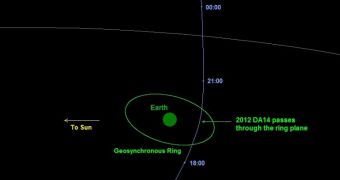Lately, doomsayers have taken an interest in asteroid 2012 DA14, a near-Earth object (NEO) that they say will collide with our planet next year. Astronomers at NASA say that there is no chance of that happening any time soon, let alone next year.
Despite the fact that scientists have proven that the space rock is not on a collision course with our planet, speculations appear to carry on as normal, with utter disregard to the actual truth. Calculations show that the NEO will simply pass very close to Earth.
The encounter is scheduled to occur on February 15, 2013. The space rock is estimated to be about 45 meters (150 feet) across, meaning that it could cause some serious damage if it impacts the planetary surface, or even if it detonates high in the atmosphere.
According to scientists, the space rock may pass closer to Earth than some of the geostationary satellites we use for navigation and positioning applications. However, the chances of it actually being diverted towards the planet itself are slim to none.
“Its orbit about the sun can bring it no closer to the Earth's surface than 3.2 Earth radii on February 15, 2013,” an online update by NASA researchers explained on March 6. The asteroid and its trajectory were analyzed by experts at the NASA Jet Propulsion Laboratory Near-Earth Object Program Office.
In other words, the NEO cannot pass closer than 12,680 miles (20,406 kilometers) to the planet's surface. The radius of Earth at its equator is about 3,963 miles (6,378 kilometers). Geostationary satellites can orbit as high as 22,245 miles (35,800 kilometers) above the planet's surface.
One of the reasons why 2012 DA14 captured the imagination of so many could be that it was discovered only recently. Astronomers at the La Sagra Observatory, in southern Spain, found it last month, during a routine survey.
The NEO makes close passes to Earth regularly, about twice per each orbit. This happens because it orbits the Sun in roughly the same orbit as our planet does.
Astronomers are taking advantage of the high media exposure this event has generated to again underline the necessity of setting up a series of small infrared observatories across the planet.
These facilities will be able to detect objects of this type in due time. In case of a real emergency, authorities around the world would have enough time to mount effective counter-measures to eliminate the threat.

 14 DAY TRIAL //
14 DAY TRIAL //